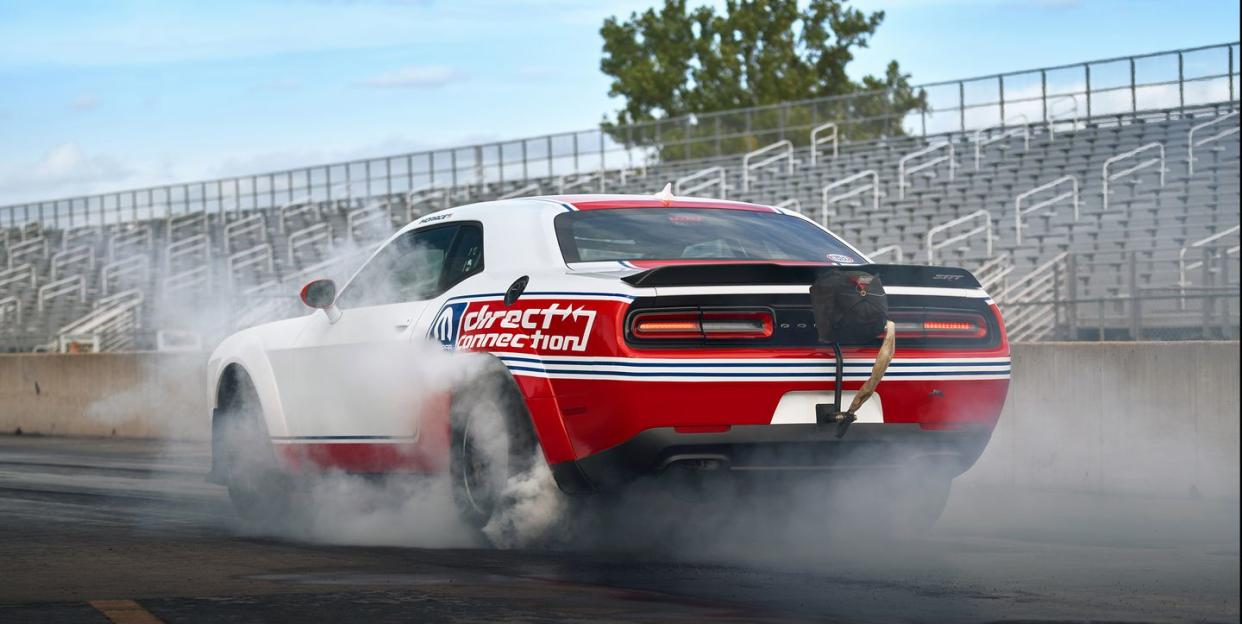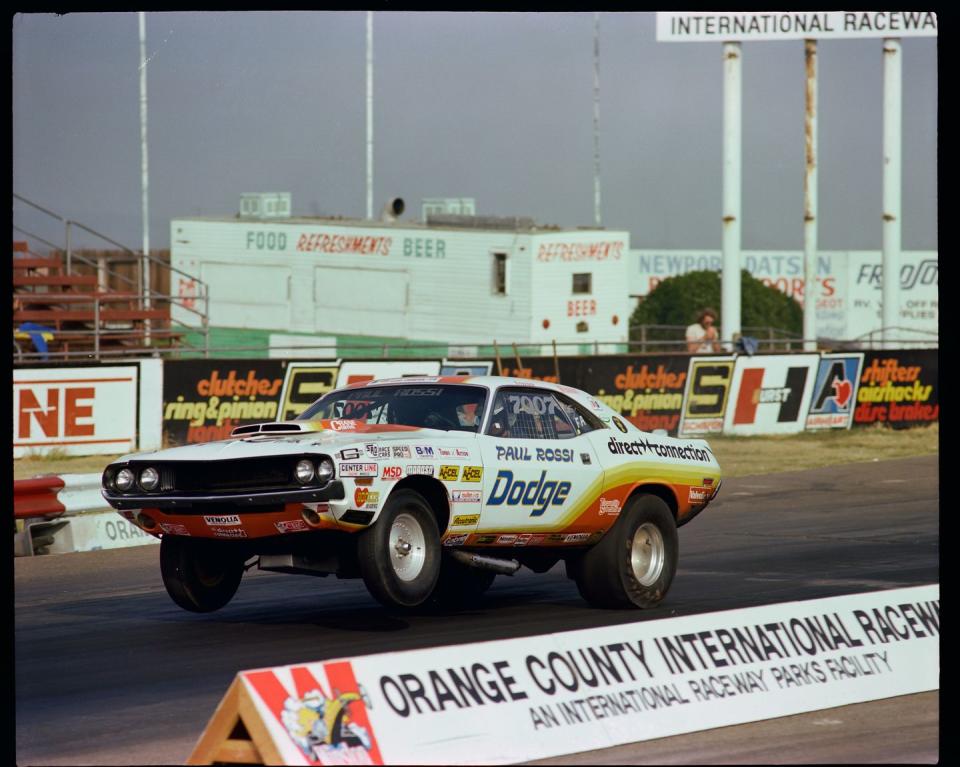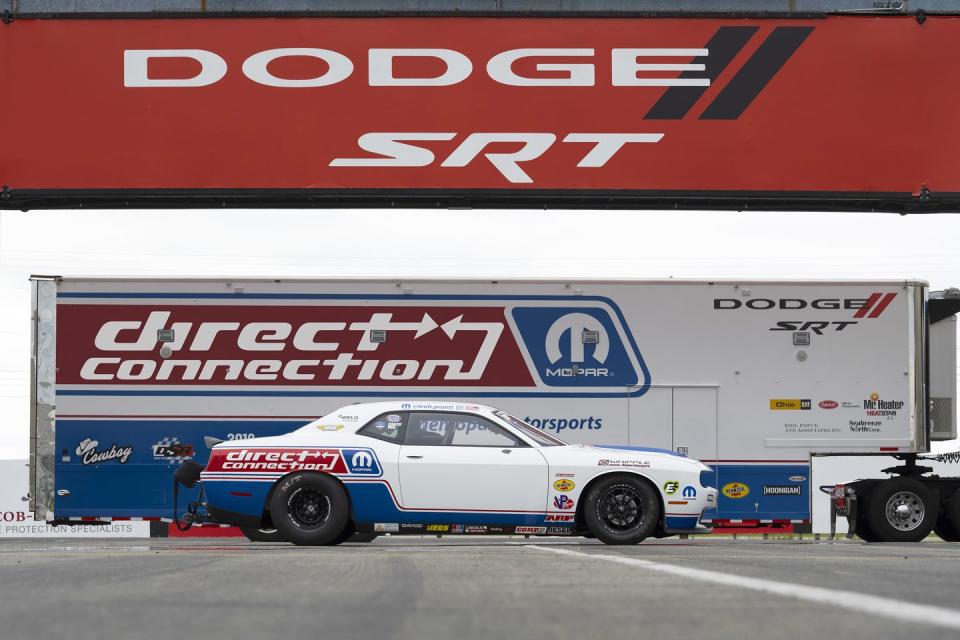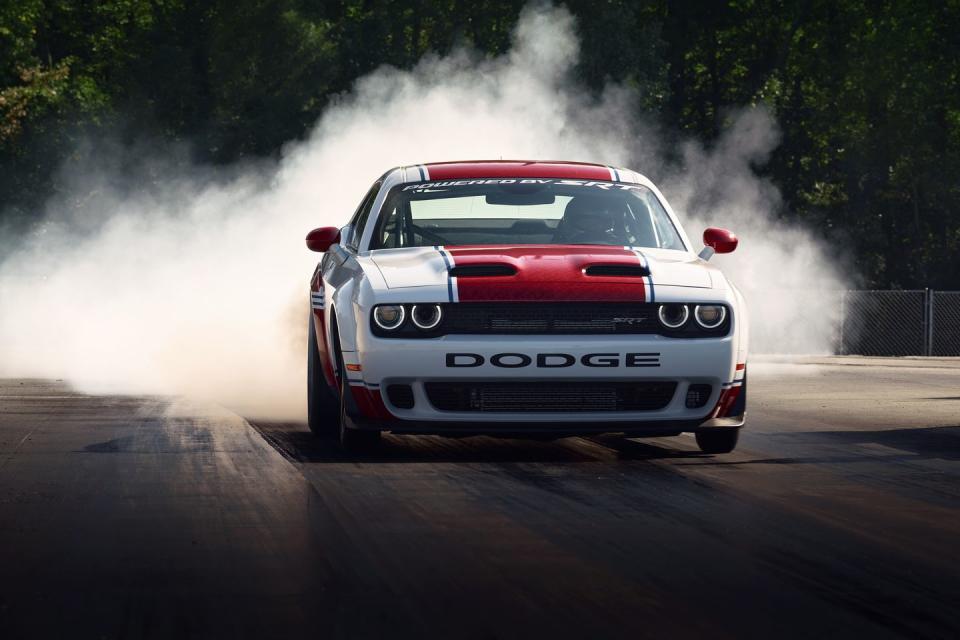Dodge Direct Connection Will Build You an 885-HP Challenger With a Full Warranty

With the return of the Direct Connection performance parts program, Dodge is opening another chapter in the story of its internal combustion muscle cars. Electrification is just around the corner courtesy of Dodge’s upcoming eMuscle program, so on its face, the rollout of Direct Connection might seem somewhat ill-timed. In order to get a better understanding of the automaker’s hopes for Direct Connection and the related Power Broker program, Road & Track sat down with Tim Kuniskis, CEO of Dodge, to discuss the brand’s latest high-horsepower onslaught.
Dodge’s Direct Connection program originally launched at dealerships back in 1974, serving as a factory source for performance parts and technical information to get the most out of your Dodge race car. In fact, Direct Connection was the first program of its kind in the industry, soon inspiring Chevy and Ford to launch their own factory-backed performance parts divisions. The original Dodge program ran until 1987, when it was rebranded as Mopar Performance Parts. The decision to resurrect Direct Connection was partly inspired by the current state of the Mopar Performance Parts catalog, specifically its focus on vintage products, according to Kuniskis.
“We’ve had performance parts through Mopar, but quite frankly, a large portion of what the customers were doing, we weren't offering,” Kuniskis told R&T. “They were modifying Scat Packs, modifying Hellcats and modifying Redeyes. We had a stronger presence in the vintage parts and less in the modern Mopar stuff. That was an opportunity for us.”

Kuniskis notes that nearly half of today’s Dodge muscle cars owners have modified their vehicles in some capacity. To that end, the company was interested in bringing the money being spent in the aftermarket back in-house.
“It's a huge side business,” said Kuniskis. “ It’s about a $23 billion industry if you go to SEMA and look at all of the modifications that are out there in the aftermarket. It’s a huge opportunity that we were barely tapping into. That’s the business case.”

While Kuniskis was happy to praise much of the work being done in the aftermarket, he didn’t hesitate to detail his hangups with the industry as a whole. Kuniskis explained that a lack of transparency, coupled with vast differences in parts quality from one outfit to the next, hurts the customer experience. If something goes wrong as a result of an aftermarket part you’ve installed, your Dodge dealer might not be able to help you out. Kuniskis knows that customers are going to continue to mod their muscle cars whether the automaker explains the consequences or not. That isn’t a situation that Dodge wants to be a part of any longer.
“The thought is, we know how to modify these cars, we’ve engineered them from the beginning,” said Kuniskis. “Let’s modify them for performance, certify them for emissions, and cover them under the warranty. The customer is going to do it anyway. They’re going to be okay with the warranty, and we don’t need any conflict with them if they have a problem, and lastly, they are safe from an emissions standpoint.”

Dodge has yet to unveil the full catalog of Direct Connection parts, but the automaker shared a few highlights coming to the Challenger lineup. The fun begins with the Direct Connection Tuner, an OBD II engine tuner that lets customers download a variety of 50-state legal tunes straight from Dodge. These ECU tunes can be combined with a variety of the automaker’s new Stage Kits, which are pre-configured for Hellcat or Redeye models. The Pre-Stage Kit adds five horsepower to Hellcats and Redeyes by way of a recalibration, and gives Redeyes a new thermostat and air cleaner. The Stage 1 Kit for the Challenger Hellcat brings the 3.17-inch supercharger pulley from the Hellephant crate engine, which combines with a tune to raise output to 757 horsepower and 696 lb-ft of torque. The Redeye Stage 1 Kit brings new software as well, bumping output to 840 horsepower and 770 lb-ft in High Octane Mode. Redeye customers can also choose the Stage 2 Kit, not available for regular Hellcats, which adds the Hellephant pulley to bring power up to 885 horsepower and 787 lb-ft.

Kuniskis notes that these upgrades have long been planned for the Challenger and Charger alike, and these vehicles have already been proven capable of withstanding the increased output. And given the fact that these power increases come with minimal hardware upgrades, Kuniskis suggests you look at it this way: Dodge has already been selling vehicles capable of nearly 900 horsepower—they’ve just been limited up until now.
In addition to the Stage Kits, Dodge will also offer customers an extensive parts list through the Direct Connection program. Hellcat owners will have access to items including upgraded cylinder heads, piston and rod assemblies, and the high-stall torque converter from the Redeye. Even owners of “regular” Challengers will have a chance to improve their rides with some Hellcat componentry, including the headlight intake system, the upgraded hood with integrated scoop, or the entire Hellcat front fascia.
For the racers among us, Dodge will also begin offering the Challenger Drag Pak as a body-in-white. This racing chassis is not street legal, but will allow customers to build their own drag racing machines via the Direct Connection catalog. The Direct Connection line will also offer upgrades including a full racing suspension system, a roll cage that’s NHRA certified to 7.50-sec. ET, and complete electrical and fuel system kits. Hemi crate engines are also on offer, ranging from a blown 5.7-liter all the way up to the 1000-horsepower Hellephant 426.

With more components yet to come from Direct Connection, there’s a bright future ahead for Hemi-powered muscle cars. That said, the profit potential from aftermarket parts was not the sole driver in this program's creation. The march toward electrification played a large role.
“The secondary reason behind this is that we want to have this really up and running smoothly as we transition to 2024 with our electrified performance,” said Kuniskis. “Because we all know that when we get into electrification, the dealers, of which we have 2500 across the country, their service and maintenance revenue is going to go down with electric cars. This is another revenue stream that was going to the aftermarket previously, and we can help dealers capitalize.”
That is where the new Dodge Power Brokers program comes into play. This is the name that will be given to enthusiast-oriented dealerships, which will be the sole provider of Direct Connection parts. Each Power Broker dealership will be staffed by certified employees with proven Mopar performance experience. These folks will understand your performance goals, and will have the knowledge and experience to help guide your upgrades. Every Power Broker employee will have a short bio online that details their know-how. Not every dealership will be allowed to join the club, with strict training and personnel requirements to ensure high-quality builds. Cars upgraded at Power Broker dealers will be covered by the full Dodge three-year/36,000-mile new vehicle warranty and the five-year/60,000-mile powertrain warranty, something no aftermarket tuner can offer.
As you might expect coming from an OEM, the Direct Connection parts aren’t going to represent the bargain sector of the market. But despite the premium pricing, Kuniskis believes customers will understand the value in production-grade engineering and testing, and appreciate the quality that comes as a result.

“Will my parts be more expensive? Sure. Absolutely,” said Kuniskis. “They will be, because I’m making sure that they are emissions compliant, I’m making sure they’ve had proper testing behind them, and I’m making sure that there's a warranty. We’re spending a lot of time and effort and money to do all of this work. I’m not saying the aftermarket doesn’t, but what I am saying is that it costs us money to do this. So our parts and our upgrades aren’t going to be the cheaper stuff on the market by far.”
With Dodge’s eMuscle electric-vehicle plan set to take center stage in the next few years, the decision to roll out an upgrade program for internal combustion vehicles seems counter to the larger industry narrative. That said, Dodge has sold quite a few of these muscle cars over the years, and they don’t plan on abandoning them once the electric machines hit showrooms. In fact, Dodge even has plans to expand the Direct Connection catalog to include parts for EV muscle cars in the future.

“Three-quarters of a million people will have the access to buy these parts, even after the vehicles leave production,” said Kuniskis. “So it is a sustainable business model. And then at the same time, it helps us transition to electrification. Maybe [EV buyers] won’t modify their cars for the first six months, first year, two years or whatever, but eventually it will be just like ICE in the life-cycle action. So we want to try and transition with both.”
Considering the sheer volume of modified Hellcats and Redeyes out there now, it does seem like Dodge has a savvy plan with this program. We know muscle cars fans are always going to welcome more horsepower, and a factory warranty surely doesn’t hurt. It will be interesting to see how the Power Brokers dealer network shakes out, and whether customers will be willing to leave their favorite aftermarket shops behind. While this current crop of Challenger and Charger models will mark the end of the gasoline era at Dodge, the brand’s passion for these unapologetically American machines isn’t going anywhere anytime soon.
You Might Also Like

 Yahoo Movies
Yahoo Movies 
